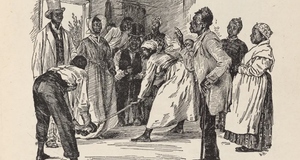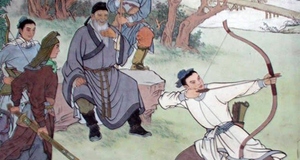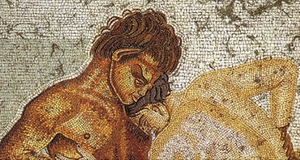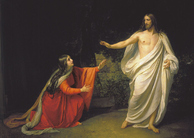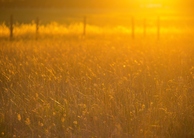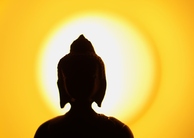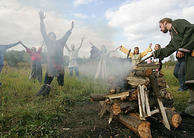Contradiction in Marriage and Love in the Song of Songs
By
2012, Vol. 4 No. 07 | pg. 2/2 | « The images of nature that are consistent throughout The Song make clear the secrecy of the lovers relationship. “Our couch is shaded with branches,” says the bride, “the beams of our house are of cedar, our rafters are all of pine” (Song of Songs 1:17). The shade keeps them hidden in their little paradise. She also says her lover has “taken me into the wine-garden,” and calls him “my dove, that hides in holes in the cliffs, or in crannies on the terraced hillside” (Song of Songs 2:4, 2:14). The lover’s hiding and the secluded natural images The Song contains keep their betrothal a secret, something they don’t show to their parents. They even begin to refer to sex itself with references to the garden. The bride asks the winds to “blow upon my garden to spread its spices abroad, that my beloved may come to his garden and enjoy the choice fruit” (Song of Songs 4:16). Combined with the virginal images of her beings a tower and a wall, the picture relayed is one of a secluded and private natural space where the lovers are free to make their own rules and to create their betrothal as they wish, instead of thinking about the right way of doing so. Although the Jewish writings often fail to create a cohesive argument, the general opinions on marriage are clear. “The ancient Jews approved of physical passion between spouses since they believed that natural forces are a good creation of God. They thought that divine grandeur could be sensed through pleasant, as well as through painful, experiences” (Phipps 7). Sexuality in marriage was not condemned within Jewish tradition. The Christian church got these ideas from “pagan religion and philosophy [where] it was commonplace to associate purity with sexual renunciation,” not the Old Testament and the Jewish tradition that came before them (Phipps 9). However it was in the discussion of the purpose of marital sexuality in which the different rabbis and communities often disagreed. For some Jews, the purpose of sexual intercourse was procreation, and only procreation. “Sexuality and procreation are sanctified by marriage, the primary purpose of which is the creation of new life” (Diamant 27). The Talmud spends many pages discussing who has fulfilled the command from God to “be fruitful and multiply” (Gn 5:2). Some rabbis even said that after a man “had children, he may abstain from the duty of procreation and he many also abstain from the duty of living with a wife” (Bokser 131). So for some, while sexual intercourse within marriage was deemed sacred, it was only so for the creation of children.Other rabbis and their followers preached the sacred relationship between husband and wife, regardless of their procreative abilities. “It is not good for man to be alone” (Gn 2:18). The rabbis discussed this at length in the Talmud. “Said R. Tanhum in the name of R. Hanilai: A person who is without a wife is without joy, without blessing, and without good” (Bokser 132). In fact some rabbis went as far as make marital sexuality a requirement. “Said R. Joshua b. Levi: A person who knows his wife to be a God-fearing woman and he does not have marital relations with her is a sinner, as it is written: ‘And you shall visit your habitation and you will not sin’” (Bokser 132). Love and pleasure between husband and wife were sacred and to disregard them was to disregard a natural creation of God. There is a possibility within the text of the Song of Songs that in some of the fragments the couple is intended to be officially betrothed or married. “First we know that nuptial feasts lasted for several days and that role-playing as royalty was customary during that time” (Phipps 6). In the song, the bride says, “While the king reclines on his couch, my spikenard gives forth its scent” (Song of Songs 1:12). The bridegroom then says after they consummate their relationship, “She made me a prince, chosen from myriads of my people” (Song of Songs 6:12). As mentioned previously, her lover often addresses the girl as “my bride,” and also in the headings of the song she is referred to as “Bride.” Then finally, is the reference to Solomon’s wedding processional. “Come out, maidens of Jerusalem; you maidens of Zion, welcome King Solomon, wearing the crown which his mother placed on his head on his wedding day, his day of joy” (Song of Songs 3:11). As one of the few mentions of an official marriage, this passage serves to bring in the possibility as it relates to the lovers. Even if the couple isn’t married, and they are clearly having sex, they are intending to be married and this is joyful. Only because of the Jewish tradition of appreciating sex (although admittedly, only martial sex) as a natural and beautiful phenomenon do the lovely images of flowers and earth and human affection work to create the unity of the whole song. Love was clearly a valued emotion by the Jewish people, and although the institution of Judaism may have been able to restrict physical love as something that only happened between married couples, the Jewish people may only have internalized the idea of love as sacred. Throughout the ages, love may grow out of a marriage, or it may start within a dalliance between young singles. The bridegroom says, “Wear me as a seal over your heart, as a seal upon your arm; for love is strong as death, passion cruel as the grave; it blazes up like a blazing fire, fiercer than any flame. Many waters cannot quench love, no flood can sweep it away; if someone were to offer for love all the wealth in his house, it would be laughed to scorn” (Song of Songs 8:7). This passage cannot exist in the poem and allow a reader to assume that lovers who revel in each other’s holiness before marriage are doomed to hell, and it remains yet another contradiction in the poem and in the teachings. The Song of Songs displays love and punishment and purity and intoxicating desire. All of the messages it encompasses don’t come together to make a coherent whole, but in light of the widely dispersed culture it came out of, this is no surprise. To its audience, this can perhaps make the poem all the more illuminating. Each reader takes from the song a strengthening of the beliefs he or she already feels to be true. This process is no different from the way that the rabbis interpreted the Bible and the Mishnah with their preconceived notions and beliefs and thus came out with very different conclusions. The Song of Songs is not weak for its contradictions and its ambiguity. It is strong for being intriguing enough to be one of the most highly debated and contemplated books of the Bible and for staying true to the world from whence it came. ReferencesBokser, Ben Zion. The Talmud: Selected Writings. New York: Paulist Press, 1989. Diamant, Anita. The New Jewish Wedding. New York: Summit Books, 1985. Holtz, Barry W. Back to the Sources: Reading the Classic Jewish Texts. New York: Summit Books, 1984. Phipps, William E. “The Plight of the Song of Songs.” Modern Critical Interpretations: The Song of Songs. New York: Chelsea House Publishers, 1988. The Holy Bible: King James Version. New York: American Bible Society, 1999; Bartelby.com, 2000. Suggested Reading from Inquiries Journal
Inquiries Journal provides undergraduate and graduate students around the world a platform for the wide dissemination of academic work over a range of core disciplines. Representing the work of students from hundreds of institutions around the globe, Inquiries Journal's large database of academic articles is completely free. Learn more | Blog | Submit Latest in Theology |









